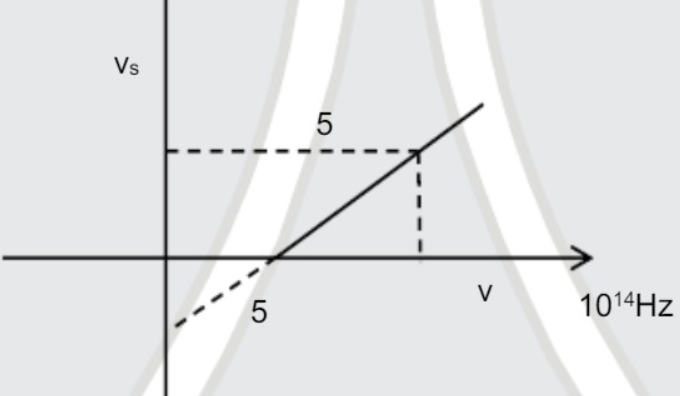Find a relation between cut-off potential, frequency of the incident light and threshold frequency.
To find a relation between cut-off potential (V₀), frequency of the incident light (ν), and threshold frequency (ν₀), we can follow these steps:
1. Start with Einstein's Photoelectric Equation:
The maximum kinetic energy (K.E. max) of the emitted electrons can be expressed using Einstein's photoelectric equation:
K.E.max=hν−W0
where h is Planck's constant, ν is the frequency of the incident light, and W0 is the work function of the metal.
2. Relate Kinetic Energy to Cut-off Potential:
The maximum kinetic energy can also be expressed in terms of the cut-off potential (V₀):
K.E.max=eV0
where e is the charge of an electron.
3. Equate the Two Expressions for Kinetic Energy:
Since both expressions represent the maximum kinetic energy, we can set them equal to each other:
eV0=hν−W0
4. Express Work Function in Terms of Threshold Frequency:
The work function W0 can be expressed in terms of the threshold frequency ν0:
W0=hν0
5. Substitute the Work Function into the Equation:
Substitute the expression for W0 into the equation from step 3:
eV0=hν−hν0
6. Rearrange the Equation:
Rearranging the equation gives us:
eV0=h(ν−ν0)
7. Final Relation:
This can be written as:
V0=he(ν−ν0)
This equation relates the cut-off potential V0, the frequency of the incident light ν, and the threshold frequency ν0.
Summary of the Relation:
The relation between cut-off potential, frequency of the incident light, and threshold frequency is given by:
V0=he(ν−ν0)
The maximum kinetic energy (K.E. max) of the emitted electrons can be expressed using Einstein's photoelectric equation:
K.E.max=hν−W0
where h is Planck's constant, ν is the frequency of the incident light, and W0 is the work function of the metal.
The maximum kinetic energy can also be expressed in terms of the cut-off potential (V₀):
K.E.max=eV0
where e is the charge of an electron.
Since both expressions represent the maximum kinetic energy, we can set them equal to each other:
eV0=hν−W0
The work function W0 can be expressed in terms of the threshold frequency ν0:
W0=hν0
Substitute the expression for W0 into the equation from step 3:
eV0=hν−hν0
Rearranging the equation gives us:
eV0=h(ν−ν0)
This can be written as:
V0=he(ν−ν0)
This equation relates the cut-off potential V0, the frequency of the incident light ν, and the threshold frequency ν0.
The relation between cut-off potential, frequency of the incident light, and threshold frequency is given by:
V0=he(ν−ν0)
Topper's Solved these Questions
- DUAL NATURE OF RADIATION AND MATTERBOOK - PRADEEPCHAPTER - DUAL NATURE OF RADIATION AND MATTEREXERCISE - NCERT Exerciese question
1 Video
- DUAL NATURE OF RADIATION AND MATTERBOOK - PRADEEPCHAPTER - DUAL NATURE OF RADIATION AND MATTEREXERCISE - Short answer
1 Video
- CURRENT ELECTRICITYBOOK - PRADEEPCHAPTER - CURRENT ELECTRICITYEXERCISE - Problems for Practice (B)
2 Videos
- ELECTROMAGNETIC INDUCTION & ALTERNATING CURRENTBOOK - PRADEEPCHAPTER - ELECTROMAGNETIC INDUCTION & ALTERNATING CURRENTEXERCISE - Multiple Choice Questions
1 Video
Similar Questions
Photoelectric work function for a surface is 2.4 eV. Light of wavelength 6.8×10−7m shines on the surface. Find the frequency of incident light and also the threshold frequency. Will there be photoelectric emission or not ?
View SolutionOne metal sphere of radius r of material with threshold frequency v0 is kept isolated and light of frequency v is incident on it. Frequency of the incident light is more than the threshold frequency of material. Find the maximum number of electrons which can be emitted from the sphere.
View Solution
Knowledge Check
In photo electric effect, the slope of the straight line graph between stopping potential and frequency of the incident light gives the ratio of Planck's constant to
Acharge of electronBwork functionCphoto electric currentDK.E. of electronAssertion : The threshold frequency of photoelectric effect supports the particle nature of light.
Reason : If frequency of incident light is less than the threshold frequency, electrons are not emitted from metal surface.AIf both assertion and reason are true and reason is the correct explanation of assertion.BIf both assertion and reason are true but reason is not the correct explanation of assertion.CIf assertion is true but reason is false.DIf both assertion and reason are false.Assertion : The threshold frequency of photoelectric effect supports the particle nature of sunlight .
Reason : If frequency of incident light is less than the threshold frequency , electrons are not emitted from metal surface.AIf both assertion and reason are true and reason is the correct explanation of assertion.BIf both assertion and reason are true but reason is not the correct explanation of assertion.CIf assertion is true but reason is false.DIf assertion and reason both are false.
Draw a graph between stopping potential and the frequency of two metals A and B having threshold frequencies v0and2v0 .
View SolutionExplain the term stopping potential and threshold frequency.
View SolutionThe de Broglie wavelenght (λ) associated with a photoelectron varies with the frequency (v) of the incident radiation as,[v0 is threshold frequency]:
View SolutionWhat is photoelectric effect? Explain experimentally the variation of photoelectric current with (i) the intensity of the incident light (ii) the potential difference between the plates and (iii) the frequency of the incident light and hence state the laws of photoelectric emission.
View SolutionGraph between stopping potential and frequency of light as shown find the work function

View Solution